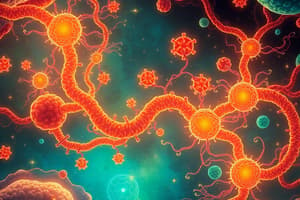Podcast
Questions and Answers
What is the primary role of pyruvate in cellular respiration?
What is the primary role of pyruvate in cellular respiration?
- It is a substrate for oxidative phosphorylation.
- It is the end product of the citric acid cycle.
- It acts as an energy-rich molecule.
- It links glycolysis and the citric acid cycle. (correct)
Which stage of cellular respiration involves the oxidation of acetyl groups to carbon dioxide?
Which stage of cellular respiration involves the oxidation of acetyl groups to carbon dioxide?
- Electron transfer chain
- Glycolysis
- Citric acid cycle (correct)
- Lactic acid fermentation
What does the breakdown of acetyl-CoA in the citric acid cycle primarily produce?
What does the breakdown of acetyl-CoA in the citric acid cycle primarily produce?
- GTP and CO2 only
- NADH, FADH2, and one GTP (correct)
- NADH and ATP only
- Only high-energy intermediates
Why is the citric acid cycle considered a 'hub' of metabolism?
Why is the citric acid cycle considered a 'hub' of metabolism?
How does the body regulate the citric acid cycle?
How does the body regulate the citric acid cycle?
Which of the following pathways is NOT an output of the citric acid cycle?
Which of the following pathways is NOT an output of the citric acid cycle?
What is the significance of forming enzyme complexes in metabolism?
What is the significance of forming enzyme complexes in metabolism?
What could be a consequence of mutations affecting the citric acid cycle?
What could be a consequence of mutations affecting the citric acid cycle?
What is the main purpose of converting the methyl group of acetyl-CoA to a methylene group in the citric acid cycle?
What is the main purpose of converting the methyl group of acetyl-CoA to a methylene group in the citric acid cycle?
Which of the following statements about the citric acid cycle is incorrect?
Which of the following statements about the citric acid cycle is incorrect?
What enzyme catalyzes the condensation of acetyl-CoA with oxaloacetate to form citrate?
What enzyme catalyzes the condensation of acetyl-CoA with oxaloacetate to form citrate?
What characterizes the citrate synthase reaction in the citric acid cycle?
What characterizes the citrate synthase reaction in the citric acid cycle?
How does the binding of oxaloacetate affect citrate synthase?
How does the binding of oxaloacetate affect citrate synthase?
Which of the following processes is NOT involved in the citrate synthase step of the cycle?
Which of the following processes is NOT involved in the citrate synthase step of the cycle?
In the context of the citric acid cycle, what does the term 'highly exergonic' refer to?
In the context of the citric acid cycle, what does the term 'highly exergonic' refer to?
Which compound is NOT produced during the first complete turn of the citric acid cycle?
Which compound is NOT produced during the first complete turn of the citric acid cycle?
What is the primary function of the PDH complex in cellular metabolism?
What is the primary function of the PDH complex in cellular metabolism?
Which enzyme in the PDH complex is responsible for the decarboxylation of pyruvate?
Which enzyme in the PDH complex is responsible for the decarboxylation of pyruvate?
Which coenzyme is associated with lipoate in the PDH complex?
Which coenzyme is associated with lipoate in the PDH complex?
Which of the following statements about the PDH complex is accurate?
Which of the following statements about the PDH complex is accurate?
What role does lipoate play in the PDH complex?
What role does lipoate play in the PDH complex?
Which vitamin is NOT a coenzyme involved in the PDH complex?
Which vitamin is NOT a coenzyme involved in the PDH complex?
Why have enzymes evolved to form complexes like the PDH complex?
Why have enzymes evolved to form complexes like the PDH complex?
How many different coenzymes does the PDH complex utilize?
How many different coenzymes does the PDH complex utilize?
Which enzyme in the citric acid cycle is involved in substrate-level phosphorylation?
Which enzyme in the citric acid cycle is involved in substrate-level phosphorylation?
Which of the following reactions in the citric acid cycle produces FADH2?
Which of the following reactions in the citric acid cycle produces FADH2?
Which statement is true regarding succinate dehydrogenase?
Which statement is true regarding succinate dehydrogenase?
Which competitive inhibitor is known to inhibit succinate dehydrogenase?
Which competitive inhibitor is known to inhibit succinate dehydrogenase?
How does fumarase exhibit stereospecificity?
How does fumarase exhibit stereospecificity?
What is the primary function of L-malate dehydrogenase in the citric acid cycle?
What is the primary function of L-malate dehydrogenase in the citric acid cycle?
Which of the following statements regarding the PDH complex is incorrect?
Which of the following statements regarding the PDH complex is incorrect?
What is the approximate ATP yield from the complete oxidation of glucose to CO2 through the citric acid cycle?
What is the approximate ATP yield from the complete oxidation of glucose to CO2 through the citric acid cycle?
What does the prefix amph- mean?
What does the prefix amph- mean?
Which key molecule is conserved in the glyoxylate cycle but not in the citric acid cycle?
Which key molecule is conserved in the glyoxylate cycle but not in the citric acid cycle?
How does the glyoxylate cycle differ from the citric acid cycle?
How does the glyoxylate cycle differ from the citric acid cycle?
What is the function of anaplerotic reactions?
What is the function of anaplerotic reactions?
Which enzyme is NOT associated with anaplerotic reactions?
Which enzyme is NOT associated with anaplerotic reactions?
In what metabolic roles do acetate groups from acetyl-CoA participate?
In what metabolic roles do acetate groups from acetyl-CoA participate?
What does the term 'cataplerotic reactions' refer to?
What does the term 'cataplerotic reactions' refer to?
What is a defining characteristic of strains of aerobic organisms regarding the citric acid cycle?
What is a defining characteristic of strains of aerobic organisms regarding the citric acid cycle?
Which enzymes are associated with tumors due to mutations?
Which enzymes are associated with tumors due to mutations?
What ability is gained by mutant NADPH-dependent isocitrate dehydrogenase?
What ability is gained by mutant NADPH-dependent isocitrate dehydrogenase?
What are metabolons described as?
What are metabolons described as?
Which intermediates play a role in the function of metabolons?
Which intermediates play a role in the function of metabolons?
What occurs within metabolons to ensure metabolic efficiency?
What occurs within metabolons to ensure metabolic efficiency?
Flashcards
What is the Citric Acid Cycle?
What is the Citric Acid Cycle?
The process of breaking down pyruvate into carbon dioxide, water, and energy (ATP) in the form of NADH and FADH2.
What are the other names for the Citric Acid Cycle?
What are the other names for the Citric Acid Cycle?
The Citric Acid Cycle is also known as the Krebs Cycle and the TCA cycle.
How does the Citric Acid Cycle work?
How does the Citric Acid Cycle work?
The Citric Acid Cycle is a cyclic series of reactions that oxidizes acetyl-CoA to CO2 and H2O, generating energy in the form of ATP, NADH, and FADH2.
What is the importance of the Citric Acid Cycle?
What is the importance of the Citric Acid Cycle?
Signup and view all the flashcards
How is the Citric Acid Cycle regulated?
How is the Citric Acid Cycle regulated?
Signup and view all the flashcards
What are the main products of the Citric Acid Cycle?
What are the main products of the Citric Acid Cycle?
Signup and view all the flashcards
How is the Citric Acid Cycle connected to glycolysis?
How is the Citric Acid Cycle connected to glycolysis?
Signup and view all the flashcards
How do enzymes work in the Citric Acid Cycle?
How do enzymes work in the Citric Acid Cycle?
Signup and view all the flashcards
Oxidative Decarboxylation
Oxidative Decarboxylation
Signup and view all the flashcards
Pyruvate Dehydrogenase Complex (PDH)
Pyruvate Dehydrogenase Complex (PDH)
Signup and view all the flashcards
Lipoate
Lipoate
Signup and view all the flashcards
Thiamine Pyrophosphate (TPP)
Thiamine Pyrophosphate (TPP)
Signup and view all the flashcards
Coenzyme A (CoA)
Coenzyme A (CoA)
Signup and view all the flashcards
Flavin Adenine Dinucleotide (FAD)
Flavin Adenine Dinucleotide (FAD)
Signup and view all the flashcards
Nicotinamide Adenine Dinucleotide (NAD)
Nicotinamide Adenine Dinucleotide (NAD)
Signup and view all the flashcards
Enzyme Complexes for Efficiency
Enzyme Complexes for Efficiency
Signup and view all the flashcards
Succinyl-CoA Synthetase
Succinyl-CoA Synthetase
Signup and view all the flashcards
Substrate-Level Phosphorylation
Substrate-Level Phosphorylation
Signup and view all the flashcards
Succinate Dehydrogenase
Succinate Dehydrogenase
Signup and view all the flashcards
Malonate
Malonate
Signup and view all the flashcards
Oxidation of Succinate to Fumarate
Oxidation of Succinate to Fumarate
Signup and view all the flashcards
Fumarase
Fumarase
Signup and view all the flashcards
Oxidation of Malate to Oxaloacetate
Oxidation of Malate to Oxaloacetate
Signup and view all the flashcards
L-Malate Dehydrogenase
L-Malate Dehydrogenase
Signup and view all the flashcards
What is the primary role of the Citric Acid Cycle?
What is the primary role of the Citric Acid Cycle?
Signup and view all the flashcards
Do the carbon atoms from acetyl-CoA leave the cycle as CO2 in the first turn?
Do the carbon atoms from acetyl-CoA leave the cycle as CO2 in the first turn?
Signup and view all the flashcards
Where does the Citric Acid Cycle occur?
Where does the Citric Acid Cycle occur?
Signup and view all the flashcards
What is the first step of the Citric Acid Cycle?
What is the first step of the Citric Acid Cycle?
Signup and view all the flashcards
What is the chemical logic behind the conversion of the methyl group of acetyl-CoA?
What is the chemical logic behind the conversion of the methyl group of acetyl-CoA?
Signup and view all the flashcards
What drives the citrate synthase reaction forward?
What drives the citrate synthase reaction forward?
Signup and view all the flashcards
Describe the induced fit mechanism of Citrate Synthase.
Describe the induced fit mechanism of Citrate Synthase.
Signup and view all the flashcards
What type of catalysis does Citrate synthase use?
What type of catalysis does Citrate synthase use?
Signup and view all the flashcards
Amphibolic Pathway
Amphibolic Pathway
Signup and view all the flashcards
Citric Acid Cycle
Citric Acid Cycle
Signup and view all the flashcards
Glyoxylate Cycle
Glyoxylate Cycle
Signup and view all the flashcards
Key Difference: Citric Acid Cycle vs. Glyoxylate Cycle
Key Difference: Citric Acid Cycle vs. Glyoxylate Cycle
Signup and view all the flashcards
Anaplerotic Reactions
Anaplerotic Reactions
Signup and view all the flashcards
Pyruvate Carboxylase
Pyruvate Carboxylase
Signup and view all the flashcards
PEP Carboxykinase
PEP Carboxykinase
Signup and view all the flashcards
Succinate Carboxykinase
Succinate Carboxykinase
Signup and view all the flashcards
Tumor Suppressor Enzymes
Tumor Suppressor Enzymes
Signup and view all the flashcards
NADPH-dependent Isocitrate Dehydrogenase and Tumors
NADPH-dependent Isocitrate Dehydrogenase and Tumors
Signup and view all the flashcards
What are metabolons?
What are metabolons?
Signup and view all the flashcards
Metabolon in the Citric Acid Cycle
Metabolon in the Citric Acid Cycle
Signup and view all the flashcards
Metabolon function
Metabolon function
Signup and view all the flashcards
Study Notes
Cellular Respiration
- Cellular respiration is the process where pyruvate, produced by glycolysis, is further oxidized to form water (H₂O) and carbon dioxide (CO₂).
Stage 1 of Cellular Respiration
- Stage 1 involves the oxidation of fuels to acetyl-CoA.
- This stage generates ATP, NADH, and FADH₂.
- Fuels include amino acids, fatty acids, and glucose.
Stage 2 of Cellular Respiration
- Stage 2 involves the oxidation of acetyl groups to CO₂ in the citric acid cycle (tricarboxylic acid (TCA) cycle, Krebs cycle).
- This pathway is nearly universal in cells.
- It generates NADH, FADH₂, and GTP.
Stage 3 of Cellular Respiration
- Stage 3 involves electron transfer chain and oxidative phosphorylation.
- This stage generates the majority of ATP from catabolism.
Principle 1
- Pyruvate links glycolysis and the citric acid cycle.
- Pyruvate's rate of partitioning affects catabolic activity.
Principle 2
- Citric acid cycle reactions follow a chemical logic.
- The cycle oxidizes acetyl-CoA to CO₂ and H₂O.
- The cycle's energy drives ATP synthesis.
- Strategies for activating groups for oxidation and conserving energy are used in other metabolic pathways.
Principle 3
- The citric acid cycle is a hub of metabolism.
- Catabolic pathways lead into it, while anabolic pathways lead out.
- Acetate groups are used in synthesizing amino acids, fatty acids, and sterols.
- Nucleotides and amino acid breakdown products are intermediates in the cycle.
Principle 4
- The citric acid cycle's central role in metabolism requires regulation.
- Regulation occurs through allosteric and covalent mechanisms.
- These mechanisms maintain homeostasis.
- Some mutations in cycle reactions can cause tumor formation.
Principle 5
- Enzymes form complexes to efficiently transform intermediates without releasing them into the bulk solvent.
- This strategy is ubiquitous in other metabolic pathways, respiration, and informational macromolecules.
Production of Acetyl-CoA
- Coenzyme A (CoA-SH) is a critical acyl carrier.
- The -SH group forms a thioester with acetate in acetyl-CoA.
Pyruvate Oxidation
- Mitochondrial pyruvate carrier (MPC) facilitates pyruvate transport into the mitochondrial membrane.
- Pyruvate dehydrogenase (PDH) complex oxidizes pyruvate to acetyl-CoA and CO₂ in the mitochondrial matrix.
- The chemical intermediates remain bound to the enzyme subunits.
- Regulation results in precisely controlled flux.
PDH Complex
- The PDH complex employs three enzymes (E₁, E₂, E₃) and five coenzymes.
- These are thiamine pyrophosphate (TPP), lipoate, coenzyme A (CoA), flavin adenine dinucleotide (FAD), and nicotinamide adenine dinucleotide (NAD).
- Lipoate acts as an electron (hydrogen) carrier and acyl carrier.
- The complex is a highly organized cluster in the mitochondrial matrix.
PDH Complex Mechanisms
- Oxidative decarboxylation is an irreversible process where the carboxyl group is removed, resulting in the formation of CO₂.
- This process involves steps 1 and 2.
- Steps 3—5 involve dihydrolipoyl transacetylase and dehydrogenase.
Citric Acid Cycle Reactions
- One oxaloacetate molecule can theoretically oxidize an infinite number of acetyl groups.
- Energy from the four oxidations is conserved as NADH and FADH₂.
Formation of Citrate
- Citrate synthase catalyzes the condensation of acetyl-CoA with oxaloacetate to form citrate.
- Citroyl-CoA is an intermediate.
- A large, negative ∆G'° is needed due to the typically low concentration of oxaloacetate.
Citrate Synthase Structure
- Oxaloacetate binding creates a binding site for acetyl-CoA.
- Induced fit decreases the likelihood of premature cleavage of the thioester bond of acetyl-CoA.
Mechanism of Citrate Synthase
- His 274 and Asp375 are acid-base catalysts in this step.
Oxidation of Isocitrate
- Isocitrate dehydrogenase catalyzes the oxidative decarboxylation of isocitrate to α-ketoglutarate.
Oxidation of α-Ketoglutarate
- α-ketoglutarate dehydrogenase complex catalyzes the oxidative decarboxylation of α-ketoglutarate to succinyl-CoA.
Conversion of Succinyl-CoA
- Succinyl-CoA synthetase (succinic thiokinase) catalyzes the breakage of the thioester bond of succinyl-CoA to form succinate.
- Energy release drives GTP or ATP synthesis (substrate-level phosphorylation).
Succinyl-CoA Synthetase Reaction
- The enzyme molecule becomes phosphorylated at a His residue in the active site.
- The phosphoryl group is transferred to ADP or GDP to form ATP or GTP.
- Animal cells contain different isozymes.
Nucleoside Diphosphate Kinase
- Nucleoside diphosphate kinase catalyzes reversible conversion of GTP and ATP.
Succinate Oxidation
- Succinate dehydrogenase, a flavoprotein, catalyzes the reversible oxidation of succinate to fumarate.
- It is an integral protein of the mitochondrial inner membrane and contains iron-sulfur clusters and FAD.
Malate Oxidation
- L-malate dehydrogenase catalyzes the oxidation of L-malate to oxaloacetate, coupled to the reduction of NAD+.
Citric Acid Cycle Regulation
- Regulation balances the supply of key intermediates with energy production and biosynthetic processes.
- Regulation occurs at the PDH complex, citrate synthase, isocitrate dehydrogenase complex, and α-ketoglutarate dehydrogenase complex.
Citric Acid Cycle and Tumours
- Mutations in the PDH complex or citric acid cycle enzymes can be oncogenic.
- Oncometabolites stimulate tumor growth.
Studying That Suits You
Use AI to generate personalized quizzes and flashcards to suit your learning preferences.




